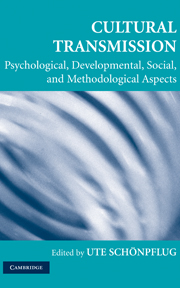Book contents
- Frontmatter
- Contents
- Foreword
- Contributors
- 1 Introduction to Cultural Transmission: Psychological, Developmental, Social, and Methodological Aspects
- 2 Theory and Research in Cultural Transmission: A Short History
- PART ONE EVOLUTIONARY PERSPECTIVE
- PART TWO CROSS-CULTURAL PERSPECTIVE
- 6 An Ecocultural Perspective on Cultural Transmission: The Family across Cultures
- 7 Intergenerational Relations and Cultural Transmission
- 8 Intergenerational Transmission, Social Capital, and Interethnic Contact in Immigrant Families
- 9 Developmental Processes Related to Intergenerational Transmission of Culture: Growing Up with Two Cultures
- 10 The Transmission Process: Mechanisms and Contexts
- 11 Accounting for Parent–Child Value Congruence: Theoretical Considerations and Empirical Evidence
- 12 Culture, Migration, and Family-Value Socialization: A Theoretical Model and Empirical Investigation with Russian-Immigrant Youth in Israel
- 13 Immigrant Parents' Age Expectations for the Development of Their Adolescent Offspring: Transmission Effects and Changes after Immigration
- PART THREE INTRACULTURAL VARIATIONS
- Index
- References
11 - Accounting for Parent–Child Value Congruence: Theoretical Considerations and Empirical Evidence
Published online by Cambridge University Press: 05 June 2012
- Frontmatter
- Contents
- Foreword
- Contributors
- 1 Introduction to Cultural Transmission: Psychological, Developmental, Social, and Methodological Aspects
- 2 Theory and Research in Cultural Transmission: A Short History
- PART ONE EVOLUTIONARY PERSPECTIVE
- PART TWO CROSS-CULTURAL PERSPECTIVE
- 6 An Ecocultural Perspective on Cultural Transmission: The Family across Cultures
- 7 Intergenerational Relations and Cultural Transmission
- 8 Intergenerational Transmission, Social Capital, and Interethnic Contact in Immigrant Families
- 9 Developmental Processes Related to Intergenerational Transmission of Culture: Growing Up with Two Cultures
- 10 The Transmission Process: Mechanisms and Contexts
- 11 Accounting for Parent–Child Value Congruence: Theoretical Considerations and Empirical Evidence
- 12 Culture, Migration, and Family-Value Socialization: A Theoretical Model and Empirical Investigation with Russian-Immigrant Youth in Israel
- 13 Immigrant Parents' Age Expectations for the Development of Their Adolescent Offspring: Transmission Effects and Changes after Immigration
- PART THREE INTRACULTURAL VARIATIONS
- Index
- References
Summary
INTRODUCTION
Values are desirable abstract goals that apply across situations. Values serve as guiding principles in people's lives, as criteria to select and justify actions and to evaluate people and events (Rohan, 2000; Rokeach, 1973; Schwartz, 1992). Values relate meaningfully to numerous important behaviors such as alcohol consumption (Schwartz, Melech, Lehmann, Burgess, Harris, & Owens, 2001), risky sexual behavior (Goodwin, Realo, Kwiatkowska, Kozlova, Nguyen Luu, & Nizharadze, 2002), vocational behavior (Knafo & Sagiv, 2004; Sagiv & Schwartz, 2004), and pro- and antisocial behaviors (Bond & Chi, 1997; Knafo, 2003a). Parents invest heavily in trying to influence their children's values. Yet, their success is quite limited; the relationship between parental and child values is far from being congruent (Homer, 1993; Knafo & Schwartz, 2001; Troll & Bengtson, 1979).
This chapter addresses the processes that lead to parent–child value congruence. By value congruence, we mean that parents and their children attribute similar importance to a value. Levels of parent–child value congruence vary as a function of the substantive content of values. Congruence is usually high for religious values and lower for most other values that have been studied (Kalish & Johnson, 1972; Miller & Glass, 1989). It is therefore important to consider the content of values when studying value transmission. The crucial content aspect that distinguishes among values is the type of motivational goal that they express (Schwartz, 1992).
- Type
- Chapter
- Information
- Cultural TransmissionPsychological, Developmental, Social, and Methodological Aspects, pp. 240 - 268Publisher: Cambridge University PressPrint publication year: 2008
References
- 12
- Cited by



